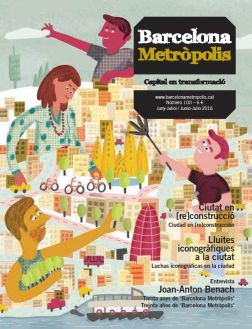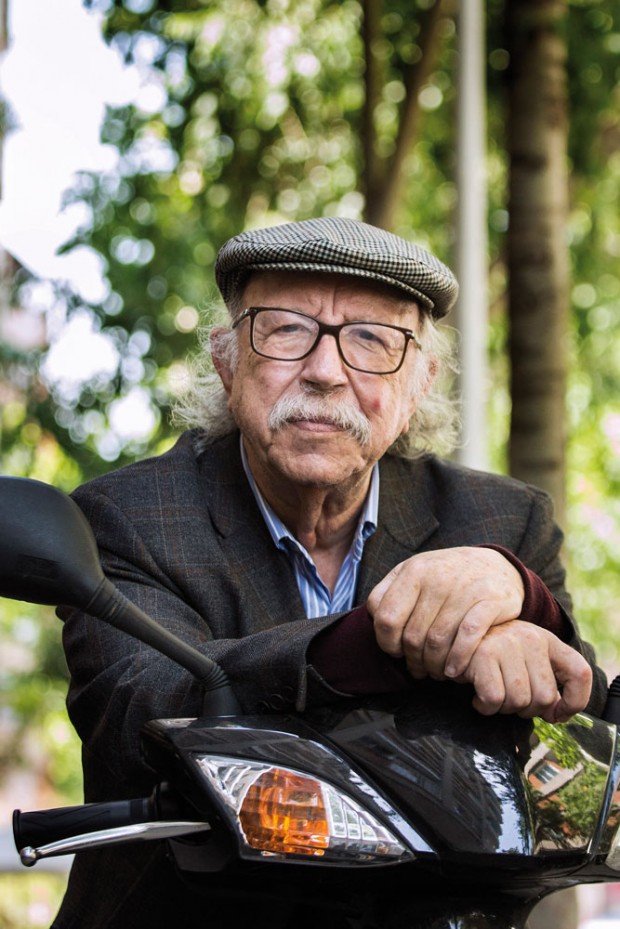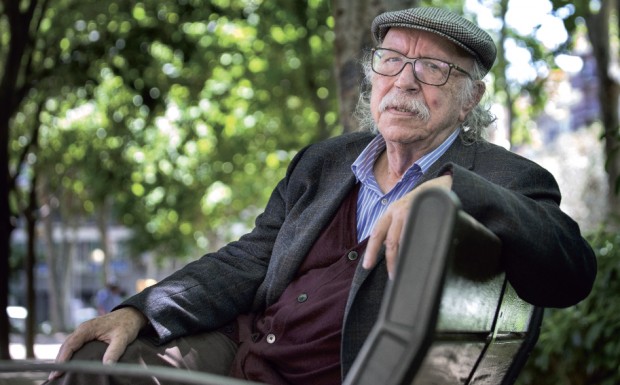Joan-Anton Benach (Vilafranca del Penedès, 1936) was the founding editor of the magazine, whose original name was Barcelona. Metròpolis Mediterrània. It was founded in May 1986, when the city was preparing and reinventing itself to host the 1992 Olympic Games. Adopting the promotional slogan of “Barcelona, more than ever” devised by the City Council, the magazine chronicled the profound changes that the city underwent. Benach retired from the City Council in in 2007, but remains very active. In fact, he arrived to this interview on his motorbike. He is a theatre critic for La Vanguardia and works every day in his office. While we were talking in a bar in the Eixample district, he received three calls on his mobile phone.
How did Barcelona. Metròpolis Mediterrània come about?
It was the realisation of an old proposal. Several journalists about my age had submitted a proposal that got tabled. Pasqual Maragall asked me to revise and update it. I was head of the City Council’s Cultural Affairs Department between 1979 and 1983, the time of the first democratic city council, and the idea of starting a magazine had always been there on the back burner. Between 1983 and 1985 I became fully involved in an exhibition on the industrial archaeology of Catalonia entitled “Catalonia, Spain’s factory”, which we did in conjunction with Economic History Professor Jordi Nadal. I participated as the curator, and we worked for almost two years to fill in 8,400 square metres of the El Born Market. After the exhibition, in late 1985, I was finally able to focus on the magazine proposal.
It was conceived as a cultural publication. Where did its name come from?
From the chatter that could be heard at that time about the reality of the metropolitan area. Pasqual Maragall’s Barcelona was very much based on the idea that the city should expand beyond its official municipal boundaries to become a full-blown metropolitan area. And including the adjective “mediterrània” (Mediterranean) was my idea. Some thought the “Mediterranean” concept was a bit naive, but we moved forward.
How was the magazine distributed?
The first distribution strategy failed. I couldn’t find anyone willing to offer selective distribution. A publication like that needed to be sold in about 20 kiosks, as it was targeted at specific sectors. We negotiated with some publishers but couldn’t make anything happen. We eventually signed an exclusive contract with an advertising agency that committed to distributing the magazine in exchange for us managing its advertising. We ran adverts for a period of time, but then the agency began to delay payments and ended up owing money to the City Council. Fortunately, this did not affect the magazine, which continued to operate normally. And then it began to be distributed, as it is to this day, through massive mailings.
As the magazine’s present editor, I have never had the misfortunate of having my articles censored or being pressed into covering a particular topic. Did you ever receive pressure from anyone?
No, councilmembers may have asked to write something, but I never allowed politicians to contribute. Councilmembers would say: “Benach won’t let me write”. And I would add: “Won’t ever”. I already had many years of experience and many councilmembers were good friends of mine from before the time I ran the Cultural Affairs Department – from my time as a journalist at El Correo Catalán. I also had another advantage, which was that Pasqual Maragall championed the publication’s independence. Sometimes a councilmember would complain about an article that had been critical of the City Council, but I liked the fact that the council’s policies could be criticised in the pages of Barcelona. Metròpolis Mediterrània. It gave us credibility. I never had problems in this regard. Maragall also defended the magazine from budget cuts that came with a new manager. Maragall gave the magazine his ironclad support and always stood up for it.
You say that articles written by councilmembers were not accepted, but the mayor did write editorials and sometimes programmatic articles were published, as in the case of issue 37, which ran a very long letter from Maragall to Jordi Pujol and Felipe González. Maybe that was the only time the rule was broken.
Yes, it was the only time. But the focus was on the status of culture in Barcelona at the time. We were running a monographic supplement at that time which explored a particular topic in depth. The supplement on theatre, for example, is still very useful as a kind of “who’s who” and “what’s what” for theatre in the city of Barcelona. These supplements were published separately. And in some cases, like the one we devoted to the 1888 Universal Exposition, it served as a catalogue of the expositions for the 100th year anniversary. Robert Hughes, the Australian writer and art critic, wrote a reference book on Barcelona in which he often quoted the magazine. He combed through every issue of Barcelona. Metròpolis Mediterrània in English and drew upon them extensively.
Hughes’ book was important during the Olympic period. Thirty years on, how do you look back on that Barcelona, the one that was just waking up and beginning to reinvent itself with the enthusiasm and innocence of those times?
It’s been thirty years! I look back on a highly improvised dynamic. From 1985 to 1992, the magazine’s driving theme was the Olympics and all efforts were aimed in that direction. Today, the opinion and leadership groups in Barcelona are much more heterogeneous than they were then, especially in the field of culture. There was a particular notion about the direction in which the city should move. I see it now as being more multifaceted, more diffuse, more broken up, especially after the 15-M anti-austerity movement. My impression as a Barcelonian is that there are many pans in the fire and it’s hard to know what to serve as the main dish. This should be a good thing, because there are many new things on the horizon of this European city. I like Ada Colau because she applies her municipal management capabilities to everything, and especially to problems. When she says “Let the refugees come!” she is really putting herself out there. As well as that, the city is doing fantastically well in a range of areas.
And after having spent so many years in the Cultural Affairs Department, what differences do you see in the way things were managed then as compared to now?
Then there was confidence in the city’s cultural management, but Barcelona’s culture was much more difficult to manage. I suffered from the non-existence of the Cultural Institute of Barcelona (ICUB), because the department could not generate its own revenue; all our revenue went into the City Council’s general coffers. We organised a presentation about Ramon Casas which generated plenty of money. It was successful. It always had long queues, and its run was extended several times. Cultural Affairs did not receive a penny of that revenue. The same thing happened with the Grec theatre festival. I managed the Grec festival four times, but we had to pretend that the City made the theatre available to certain companies, because Cultural Affairs could not charge anything on its own.
Prior to joining the City Council you spent many years at El Correo Catalán, where you came into your own as a journalist.
When I got the idea for Barcelona. Metròpolis Mediterrània, I was motivated more by curiosity about cultural issues than my experience as a journalist. Newspapers have a different dynamic. At El Correo Catalán, I edited the cultural section for many years before becoming editor-in-chief. We had to come out with a newspaper every day, which was very different to producing a magazine. I had been specialising in local policy issues and wrote a daily column, in which I was highly critical of the municipal policies of then mayor Josep Maria de Porcioles. And one got censored. Censorship cast a long shadow; the censor kept your articles. One day, an officer from the Barcelona delegation of the Ministry of Information and Tourism showed me my file, which was quite thick. Other colleagues of mine, such as Josep Pernau, had files that were even thicker. As a member of my then current party CC (first called Crist Catalunya, then later Comunitat Catalana, before becoming secular and changing its name to Força Socialista Federal, FSF, when Pujol was sent to prison), I was editor of the magazine Promos. That job earned me a fine and a disciplinary proceeding. Manuel Fraga closed it and wanted to send me to prison. The Press Act was enacted to exercise control over all news and journalistic activities. They abolished Signo, a Catholic magazine with a high circulation; they also closed down a communist magazine in Valencia. Eventually the ministry blackballed me. In 1966, leaning on the Press Act, Fraga told the editor of El Correo Catalán that I could no longer write any articles that were not about culture, and hence I was exiled to the cultural section. They also blackballed Casimir Martí and Joan Fuster. I was in good company.
Culture as something innocuous.
Exactly. Culture seen as something harmless. And even then, they censored many of my theatre reviews.
Under your editorship, the magazine had a couple of very clear phases when the focus was on major events in the city. First the Olympics and then the 2004 Forum.
I think the Forum stage was a bit murky. From the urban planning perspective, it made sense and worked, but it didn’t fit in well with the city or with the people. The city’s current pulse is something that I understand very intuitively. It’s a city that has supported cultural events such as Sónar and Primavera Sound, which were targeted at specific groups. I also notice the lack of a thorough approach to tourism, and particularly to heritage tourism. There is now a dynamic of taking things as they come, because the demand is there, but what we really need is quality tourism. La Rambla has been hijacked and we don’t seem to mind that much. We need to systematically reflect on the way Barcelona should react to this unstoppable surge in tourism, which has come on rather suddenly, like an avalanche.
Recent issues have featured some highly critical articles.
The cultural map that is emerging from this magazine is not at all bad. As I said, the aim had always been to develop the cultural sphere. As Cultural Affairs Director I oversaw twenty-four museums and the municipal orchestra’s musicians; a staff of five hundred were under my charge.
You were the ones running the show.
At that time the job of councilmember was an elected position, but they didn’t work as much as they do now. Department directors, in contrast, were treated as “illustrious” individuals; that’s why I always said that my funeral would be paid for by the City Council. It was actually very hard work, something which needed to be explained to be understood. We made a museum map. We saw the need for a section where we could present, in a very specific way, the best pieces from the museums. We gave special attention to the city’s museums as part of the effort to create a heritage inventory. But we also emphasised photography, design and literature. We also wanted to include urban planning and architecture as important aspects of Barcelona’s culture. Oriol Bohigas had a particularly positive attitude towards the magazine and gave us lots of support.
In this regard, the special supplements filled a need not met by other magazines and media outlets.
They were so successful that in some cases we reissued them separately.
Today there is a raft of cultural magazines out there, mainly online, but things were different then.
That worried me. I don’t think that Barcelona. Metròpolis Mediterrània could have been compared with any other magazine at the time. There was one that I considered reprehensible and which I had to distance myself from as an example of what the City Council should not have done. Its name was San Jorge, published by the Barcelona Provincial Council, in Spanish. That was when everything was done in Spanish. It was a magazine for staff members filled with photos of inaugurations and political “posers”. Barcelona. Metròpolis Mediterrània didn’t compete with other media outlets and was well received by the newspapers.
Did you hold any public events related to the magazine?
Yes, when a new issue came out we often invited journalists to a breakfast and held a press conference in one of those majestic rooms at the City Hall, with white-gloved porters. Journalists did show up for those breakfasts, needless to say.
That would be unthinkable today.
When I retired in 2007, they threw me a farewell party at the City Hall. A great many people from the world of culture were there, everyone who had contributed to the magazine. I have very good memories of that.





